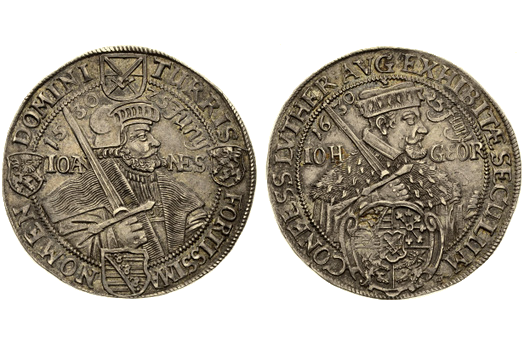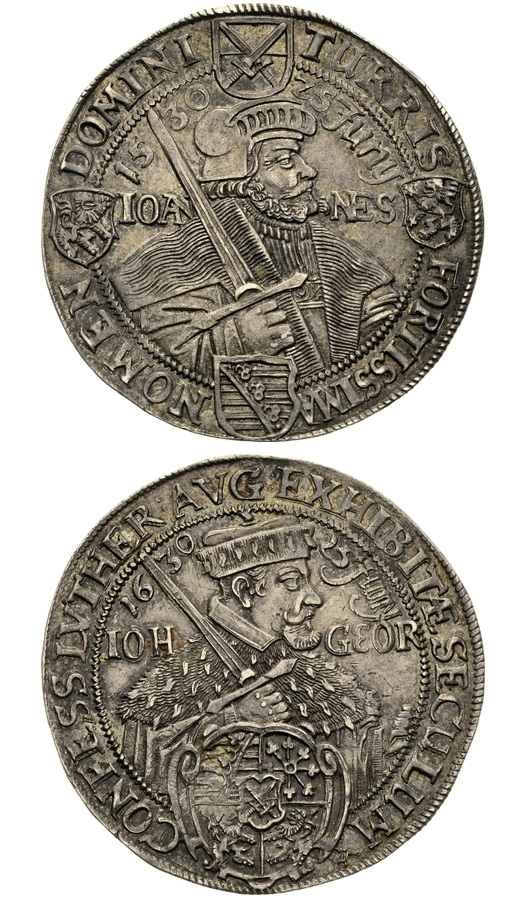
about ancient nomos
Ancient Nomos Art is a museum of galleries exhibiting ancient coins and ancient mint maps. The coin gallery displays the diverse art and history of hand-crafted ancient Greek, Roman, Byzantine, Persian and Medieval coinage. The ancient mints mapping gallery features Greek, Roman, Byzantine, Asia Minor and Medieval mint city regions and territories. Visitor's are welcome to explore, study and enjoy Ancient Nomos Art.

Post-Medieval Saxony – 1630 AD
Johann Georg I
From Ancient Galleries

Obverse: Capped half-length bust of Johann “the Steadfast” with ornamented breast stripe, holding sword in right hand over his shoulder.
Reverse: Capped half-length bust of Johann Georg I, left hand on beaded border and right hand holding sword over his shoulder.
ENLARGEMENTS

LEGENDS
Commemorative Augsburg Confession Halbtaler Centenary Issue.
Mint issued dates: 25 June 1530 AD and 25 June 1630 AD
Elector of Saxony: Johann Georg I
Obv: TURRIS FORTISSIMA NOMEN DOMINI, Capped half-length three quarter turned bust of Johann “the Steadfast” with ornamented breast stripe, holding sword over shoulder; dated 1530 25 JUNY / IOAN NES in fields; four coats of arms around. Rev: CONFESS : LUTHER : AUG EXHIBITÆ : SECULUM, capped half-length bust of Johann Georg facing right, left hand on beaded border, right hand holding sword; dated 1630 25 JUNY / IOH GEOR in fields; large coat-of-arms below.
This exemplary Augsburg Confession silver halbtaler coin was issued to mark the centenary of Martin Luther’s reformation thesis. Known as the “Jubilee Thaler” commemorative coinage, this historically important coin was struck on June 25, 1630 AD to celebrate the 100th anniversary of the Augsburg Confession (Confessio Augustana), the official document and beginning of the Protestant Reformation. The Augsburg Confession is the primary confession of faith of the Lutheran Church and the most important document of the Protestant Reformation. The Confession was written in both German and Latin and was presented by a number of German rulers and free-cities at the Diet of Augsburg on June 25, 1530 AD. One hundred years later, Emperor Ferdinand II pledged to re-Catholicize church property in Europe and issued the Edict of Restitution on March 6, 1629 AD. The Edict claimed church property shall be brought back to the status of 1552 AD, before the Peace of Religion in Augsburg, without the evangelical imperial estates consent. The Protestant electors of Saxony, Brandenburg and Germany were bitterly opposed to the edicts and resisted all efforts to restitute church properties. On April 12, 1630 AD, Elector Johann Georg I of Saxony convened a convention of theologians under the direction of the electoral Saxon court preacher Matthias Hoe von Hoenegg in Leipzig. The Electors delivered a letter to the Emperor rejecting Augsburg church closures and decided to hold a nationwide three-day jubilee festival from June 25 to 27, 1630 to celebrate the Augsburg Confession centenary anniversary. For this celebration, the medal artist Ruprecht Niclas Kitzkatz designed coin images for the anniversary coins in the Dresden Mint. The Dresden mint engaged the finest artist’s in Europe to engraver the taler coinage dies. In fact, due to the large number of minted coin denominations and the associated die wear, Kitzkatz had to deliver many additional dies, which created a large number of different coin design variants. The coins bear the portraits of Elector Johann the Steadfast (1530) and Elector Johann Georg I (1630) of Saxony. The Latin inscription on the Johann the Steadfast side reads: NOMEN DOMINI TURRIS FORTISSIMA (The name of the Lord is the strongest bulwark). This legend is a variation on the original text from the biblical Proverbs of Solomon text, chapter 18 verse 10. The Latin inscription on the Johann Georg I side reads: CONFESS (ionis): LUTHER (i): AUG (ugustanae): EXHIBITAE SECULUM (The era of Luther’s Confession delivered over to Augsburg). After the word SECULUM one finds the secret crossed swords symbol that identifies the Dresden mint master Hans Jakob.
SPECIAL FEATURE EXHIBIT
The ANAM Special Features gallery examines the royal Renaissance fashions depicted on this Augsburg Confession commemorative halbtaler. The historically important “Jubilee Thaler” dually dated coin celebrates both the 100th anniversary of the Augsburg Confession and the historic royal clothing fashions on Electors Johann ‘The Steadfast’ (1530 AD) and Johann Georg I (1630 AD) of Saxony. To view the Renaissance fashions study in the Special Features gallery, please use the following link: Royal Renaissance Fashion Study Special Features Exhibit
DOCUMENTATION
Value: Commemorative Halbtaler (half taler). Metal: AR Silver. Weight: 14.39 grams. Mint: Dresden, Saxony. Date: Struck 25 June 1630 AD. Die variant: Ornamented breast stripe on Johann the Steadfast.
Attribution: C&K 324b; Kohl 210 Collection; Engelhardt 640 Collection; Merseburger 1065; Weidner B11; Schnee 860; Davenport 7605. Photo courtesy: Holn Leipziger Munzhandlung.
Legend, Documentation and Attribution
